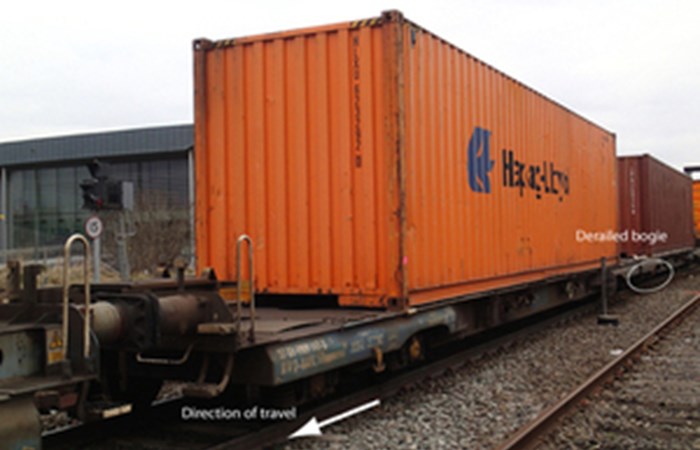Rail Accident Investigation Branch

At 08:03 hrs, the failure of signalling equipment in the vicinity of Washwood Heath West Junction, following the passage of train 4O14, alerted the Network Rail signaller to a possible problem with that train. It was subsequently discovered that the train had derailed and then re-railed when crossing from the Up Derby Slow line to the Down Derby Fast line. The train was brought to a stand at Landor Street Junction at 08:10 hrs and the driver was asked to examine the train. He found evidence that the 10th wagon on the train had run derailed.
Train 4O14 was the 05:58 hrs Basford Hall (Crewe) to Southampton container service. It consisted of a Class 66 locomotive pulling a mix of 24 container wagons and had been travelling at 15 mph while negotiating a series of crossovers. The wagon that derailed was an IKA wagon (8049091473), consisting of two flat wagons permanently coupled together. Examination of the track confirmed that the train had run derailed for a distance of 121 metres, before re-railing at a set of trailing points. The derailment caused significant damage to track and signalling equipment. No-one was injured.
After examination by RAIB, the train was taken into the nearby Lawley Street freight terminal where the wagon which derailed was removed and quarantined by the RAIB. The rest of the train later continued its journey to Southampton.
The RAIB examination of the train revealed that the third bogie on wagon 10 had derailed. Both left-hand wheels of the bogie (the leading bogie of the rearmost half of the twin set) climbed over the left-hand closure rail of 802B points, which the train was traversing in the trailing direction.
The derailed twin set carried two 40 freight containers, one centrally located on each part of the wagon. RAIB examined the load inside the containers. The container on the front part of the twin set was empty and the container on the rear part appeared to be evenly loaded with bagged scrap plastic fragments.
Site measurements indicated there was a significant track twist close to the point of derailment. This twist was of a magnitude which Network Rails track maintenance standard required to be rectified within 36 hours of detection. Network Rails records indicate that five of the timber bearers supporting the track at the point of derailment had been replaced two weeks before the derailment. RAIB observed that some of the baseplates on these timbers had been replaced in incorrect positions.
Testing of the derailed wagon revealed that its wheel unloading in a simulated track twist did not meet the criteria laid down in the relevant Railway Group Standard, GM/RT2141. A strip down and examination of the wagon revealed that the centre pivot liners had worn beyond their maintenance limit. The centre pivot liner is made from a friction material and is provided to allow relative movement between the body centre pivot and the bogie. There is evidence that the wear of the liner had restricted the freedom of the bogie to rotate, increasing its rotational stiffness. Furthermore, it resulted in reduced side bearer clearances, increasing the wheel unloading in track twist conditions. Both the increased rotational stiffness and the increased wheel unloading will have reduced the wagons resistance to derailment.
The ongoing investigation will examine both the sequence of events that led to the track twist, and why the wagons centre pivot liners were allowed to deteriorate to such an extent without being identified and replaced.
Our investigation will examine the sequence of events leading up to the incident, including the replacement of the timber bearers, and the cause of the derailment, taking consideration of the significance of the track twist and the condition of the wagon.
Our investigation is independent of any investigations by the safety authority for GB railways (the Office of Rail and Road).
We will publish a report, including any recommendations to improve safety, at the conclusion of its investigation. This report will be available on our website.
You can subscribe to automated emails notifying you when we publish our reports.
